Theme Parks & Themed Entertainment
Wednesdays with Wade: Disneyland’s First Tinker Bells
Wade Sampson returns with a tale about the trio of ladies who were the first to leap off of the Matterhorn, gracefully fly over Sleeping Beauty Castle … and then slam into a full-sized body-mitt at the off-stage end of that cable.

With the announcement that Tinker Bell will be making a new flight path around Sleeping Beauty Castle at Disneyland as part of “The Happiest Celebration on Earth,” I thought I would dig through my files to find information about the three early Tinker Bells who created the tradition beginning with the first flight in the Summer of 1961.
That first Tinker bell was Tiny Kline. Tiny Kline came to America as a Hungarian immigrant at the age of fourteen as part of a dance troupe. Upon arriving in America, she lived in the Clara de Hirsch Home, a boarding house and industrial school in New York City for Jewish immigrant working girls. It was a place where young women could learn proper conduct in preparation for becoming domestic servants or needle workers.
Kline rejected that life to become a well-known and popular burlesque dancer. She also worked off-Broadway in theater productions and caught the attention of a well-known Wild West trick rider whom she married shortly thereafter. Five weeks after the wedding, he fell off of his horse and died, leaving Kline to begin her own career in the circus.
Starting at the bottom as a virtually nude, painted “statue girl,” she worked her way up to “Roman rider” which meant she stood atop a charging steed in the chariot races at the end of the show and eventually became the queen of the aerial iron jaw act. That act became her trademark when she performed for Ringling Brothers.
Kline, at age 70, became the very first Tinker bell at Disneyland. Suspended 146 feet up in the air, she glided down a long wire from the Matterhorn to Sleeping Beauty’s castle to signal the beginning of the fireworks.
Kline kept a diary and reportedly circus historian Professor Janet Davis is annotating it for future publication by the University of Illinois Press. The working title is “The Tiny Kline Papers: From Titillation to Tinker Bell”.
Kline performed for the next three summers but in 1964, health problems required her to hand over the wand (and harness) to nineteen-year old French circus acrobat Mimi Zerbini. Zerbini was also a circus family veteran but only performed as Tinker Bell for that one summer.
In 1965, Judy Kaye began a career of more than a decade of flying across the night sky at Disneyland. Kaye stood five foot, one and seven-eighth inches tall. She was born into a circus family and paid her first visit to a circus arena when she was barely three weeks old.
She became an aerialist “since I was old enough to walk…Balance and natural strength have always been easy for me-I guess I’m half monkey!” Judy announced in 1977.
Her father, Terrell Jacobs, worked with lions and tigers for the Ringling Brothers Circus. Her mother, Dolly, was a dancer and an aerialist who eventually became grounded due to a series of falls and eventually turned to working with animals as well.
When Walt Disney began making films featuring live animals, many of the animal stars were owned and trained by Judy’s mother. Walt even included the animals in the old Disneyland Mouseketeer Circus (that only ran from November 1955 to January 1956).
Judy remembers that in those days they had a young Indian elephant owned by her mom. Walt walked up to the baby pachyderm and exclaimed: “That’s Dumbo!” Judy’s mom corrected Walt, “But her name’s Dolly.” “From now on,” proclaimed Walt, “she’s Dumbo.”
Years later, “Dumbo” became part of Judy’s circus act as well as a personal pet. “My first love is Dumbo-but my second is Disneyland,” stated Judy in 1977, “I love doing Tink because of the flying. I’m partially a ham anyway. I enjoy my work…I wouldn’t otherwise do it. In show business I can put froth what I’ve been observing and learning all my life. I like satisfying people. Show people stay young-Tiny Kline was a classic example of that.”
When not performing as Tinker Bell, Judy still trained and worked with animals as well as designing and making circus costumes. Her husband, Paul V. Kaye, had his own circus that toured internationally.
Judy and her husband also were co-partners in a talent agency and booked some of the talent that toured the U.S. and Europe as part of the “Disney On Parade” show.
A mid-Seventies issue of the cast member magazine “Backstage” described Judy’s night routine as Tinker Bell. (Remember that at the highest point, she is on a wire about 150 feet in the air while most high wire acts in the circus are done no more than 50 feet above the ground.):
“Shortly before 9 p.m. each night during the summer, Judy steps through the doors of the Entertainment Office above America Sings, dressed in her street clothes, with her long dark hair tucked neatly up on top of her head. She’s whisked into a nearby office with a Wardrobe Hostess and minutes later Tink herself emerges, ready for another flight.
A scarf securely covering her blond curls and a coat tossed over her sparkling costume, she moves discreetly through the crowds with the launching half of her crew out to the Matterhorn. Deftly reaching the top via a series of stairs, elevators, more stairs and ladders. Tink and her team now begin the crucial pre-flight preparation.
She’s helped into her harness (a bulky contraption somewhat resembling a parachute set-up), her wings are attached, she’s hooked up to the cable, the wire is given a last-minute test, the launcher takes her by the ankles and positions her for the impending take-off, and they wait for the go-signal.
In the meantime, three other team members are waiting high atop the catching tower behind the Fantasyland break area, ready for Tink’s arrival.
And all this time, the Main Street Electrical Parade is winding its way through the Park. Once the last float has disappeared, guests are alerted by the ‘Voice of Disneyland’ to look into the skies over Sleeping Beauty’s Castle where Tinker Bell will soon light the night with Fantasy in the Sky.
Back up on the mountain, another recorded click-track tape counts off the moments remaining before take-off. ‘Tinker Bell, you have 45 seconds….35 seconds…25 seconds…15 seconds…10 seconds…5-4-3-2-1-Go Tinker Bell!’ And down on the ground, thousands of eyes gaze up to see the glittering pixie breeze gracefully through the dark skies, turning on fiery color with the mere touch of her magic wand.
Approximately 30 seconds from the time she leaves the mountain top, she ‘lands’ at the tower, sometimes coming in easily, sometimes rapidly and packing a real whollop, depending on a number of factors such as weather and speed of flight. At this end, the other half of her crew ‘catches’ her in a large, padded body mitt, calls the mountain to let them know she made it and how, unhooks her from the cable, de-wings her, and she’s down and off in a waiting van, back to the Entertainment Office where she becomes Judy Kaye once again.”
And while we are talking about Tinker Bell, let’s not forget that coming out this year is a much anticipated book entitled “Tink Talks: The Secrets Behind the Wings” by Margaret Kerry from Ape Pen Publishing. Margaret was the live action reference model for Tinker Bell for the Disney animated feature but her career is much richer than just that credit.
Television & Shows
The Untold Story of Super Soap Weekend at Disney-MGM Studios: How Daytime TV Took Over the Parks
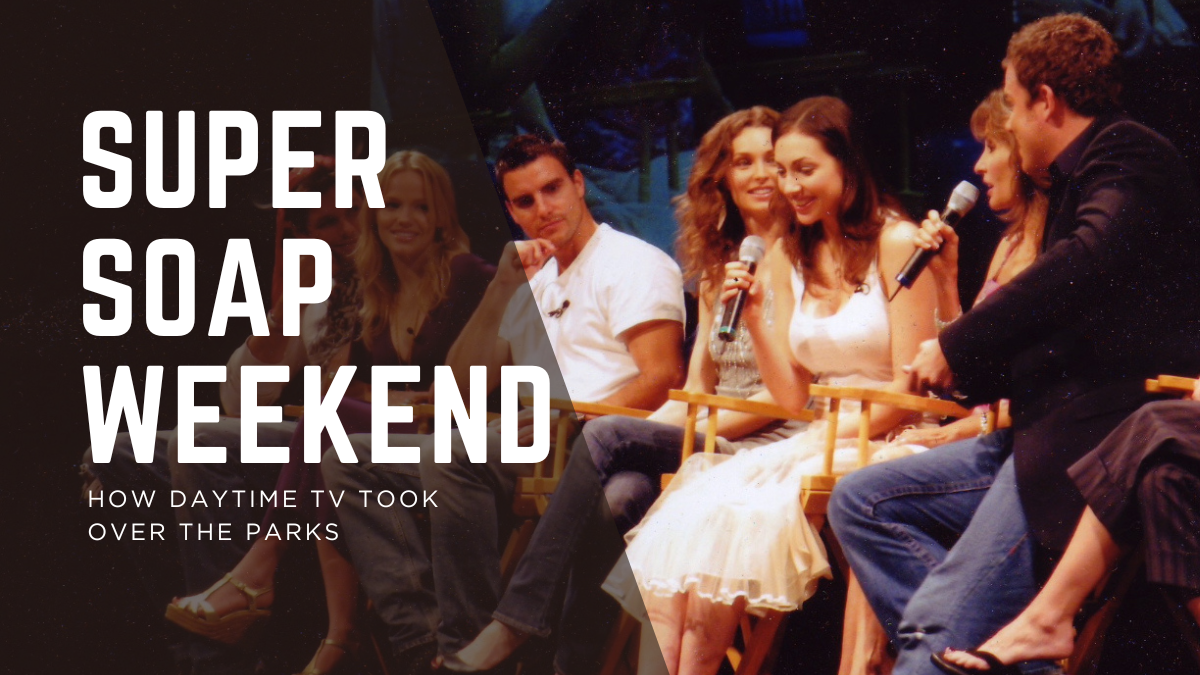
A long time ago in a galaxy that … Well, to be honest, wasn’t all that far away. This was down in Florida after all. But if you traveled to the WDW Resort, you could then experience “Star Wars Weekends.” Which ran seasonally at Disney’s Hollywood Studios Disney World from 1997 to 2015.
Mind you, what most folks don’t remember is the annual event that effectively plowed the road for “Star Wars Weekends.” Which was “Super Soap Weekend.” That seasonal offering — which allowed ABC soap fans to get up-close with their favorite performers from “All My Children,” “General Hospital,” “One Life to Live” and “Port Charles” — debuted at that same theme park the year previous (1996).
So how did this weekend-long celebration of daytime drama (which drew tens of thousands of people to Orlando every Fall for 15 years straight) come to be?
Michael Eisner’s Daytime TV Origins and a Theme Park Vision
Super Soap Weekend was the brainchild of then-Disney CEO Michael Eisner. His career in media began with short stints at NBC and CBS, but it truly took off in 1964 when he joined ABC as the assistant to Leonard Goldberg, who was the network’s national programming director at the time.
Eisner quickly advanced through the ranks. By 1971, he had become Vice President of Daytime Programming at ABC. That meant he was on the scene when One Life to Live joined the lineup in July 1968 and when All My Children made its debut in January 1970. Even after being promoted to Senior Vice President of Prime Time Programming in 1976, Eisner stayed close to the daytime division and often recruited standout soap talent for ABC’s primetime shows.
Fast forward nearly two decades to July 31, 1995. The Walt Disney Company announced that it would acquire ABC/Cap Cities in a $19 billion deal. Although the acquisition wasn’t finalized until February 1996, Eisner was already thinking ahead. He wanted to use the stars of All My Children, One Life to Live, and General Hospital to draw people to Disney’s theme parks.
He had seen how individual soap stars were drawing huge mall crowds across America since the late 1970s. Now he wanted to bring dozens of them together for something much bigger.
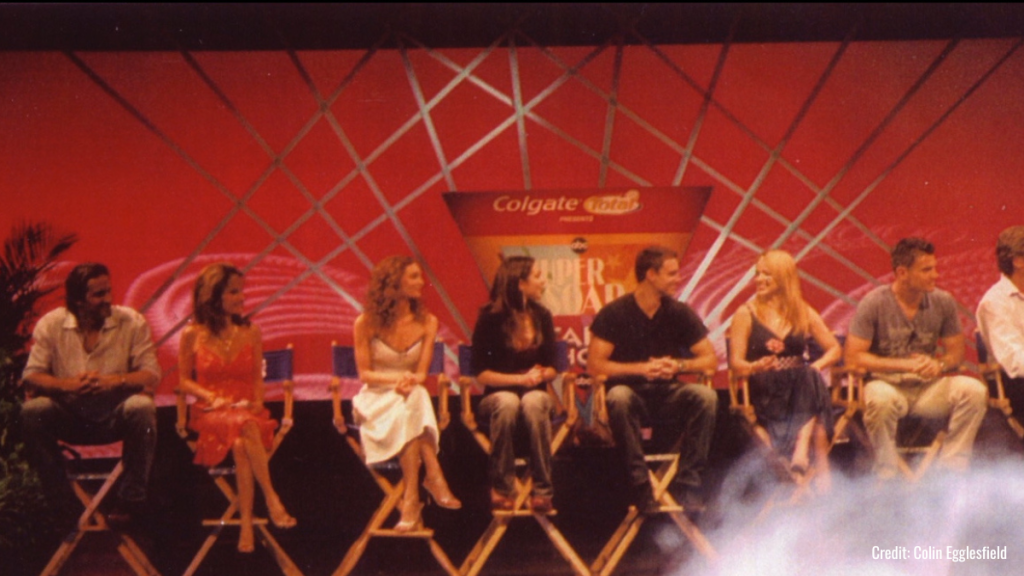
Super Soap Weekend Takes Over Disney-MGM Studios
The very first Super Soap Weekend was announced in June 1996, just a few months after the ABC deal closed. The event was scheduled for October 19 and 20 at Disney-MGM Studios and was a massive success.
The weekend featured panel discussions, autograph sessions, and photo opportunities with the stars of ABC’s daytime dramas. Thousands of fans packed the park for the chance to meet their favorite actors. Due to the overwhelming response, the event became an annual tradition and was eventually moved to Veterans Day weekend each November to better accommodate attendees.
Longtime fans like Nancy Stadler, her mom Mary, and their close friend Angela Ragno returned year after year, making the event a personal tradition and building lifelong memories.
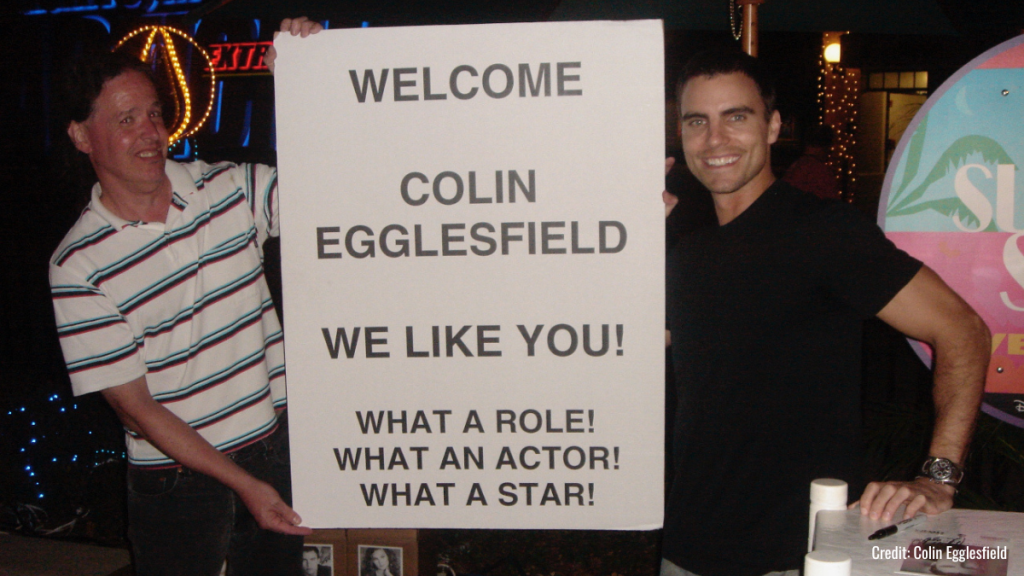


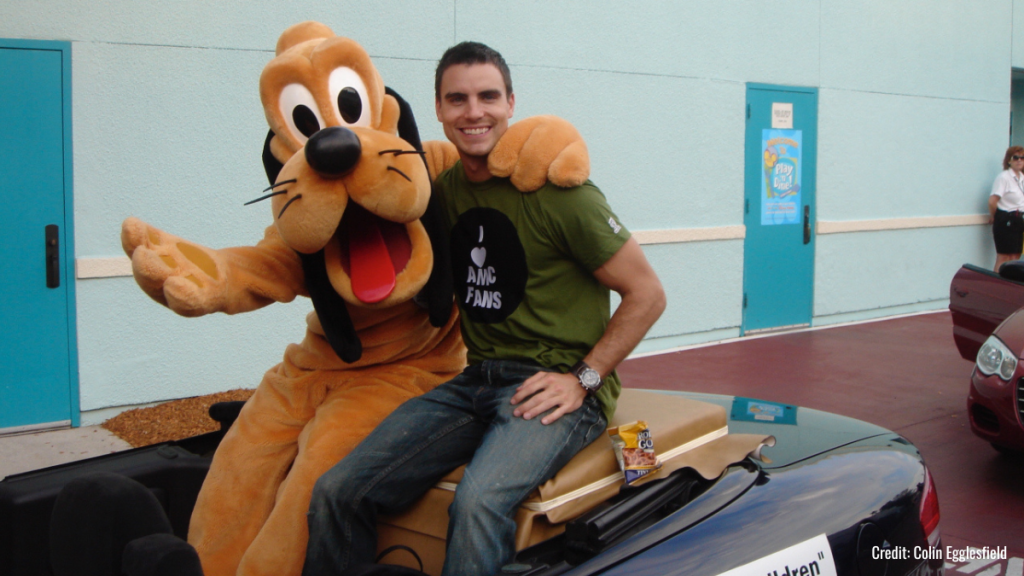
West Coast Events and the ABC Soap Opera Bistro
Disney even tried to recreate the event out west. Two Super Soap Weekends were held at Disneyland Resort, one in April 2002 and another in June 2003.
At Disney’s California Adventure, Eisner also introduced the ABC Soap Opera Bistro, a themed dining experience that opened in February 2001. Guests could dine inside recreated sets from shows like General Hospital and All My Children, including Kelly’s Diner and the Chandler Mansion. The Bistro closed in November 2002, but for fans, it offered a rare opportunity to step into the world of their favorite soaps.
SOAPnet, Port Charles, and the Expansion of Daytime TV at Disney
Eisner’s enthusiasm for soaps extended beyond the parks. In January 2000, he launched SOAPnet, a cable channel dedicated to prime time replays of ABC’s daytime dramas.
During his time at Disney, General Hospital also received a spin-off series titled Port Charles, which aired from June 1997 to October 2003. The show leaned into supernatural plotlines and was another example of Eisner’s commitment to evolving and expanding the soap genre.
The Final Curtain for Super Soap Weekend
In September 2005, Eisner stepped down after 21 years as head of The Walt Disney Company. Bob Iger, who had previously served as President of ABC and Chief Operating Officer of ABC/Cap Cities, took over as CEO. While Iger had deep ABC credentials, he didn’t share Eisner’s passion for daytime television.
In the fall of 2008, Disney hosted the final Super Soap Weekend at what was then still called Disney-MGM Studios. That same year, the park was rebranded as Disney’s Hollywood Studios, and Disney began shifting away from television-focused experiences.
Within the next five years, the rest of Eisner’s soap legacy faded. One Life to Live was canceled in January 2012. SOAPnet was rebranded as Disney Junior in February 2013. Later that year, All My Children ended its 41-year run on ABC.
Only General Hospital remains on the network today, the last standing soap from the golden age of ABC Daytime.
A New Chapter for Daytime TV and Super Soap Fans
The soap genre may have faded from its former glory, but it’s not gone. On February 24, 2025, CBS premiered a brand-new daytime drama called Beyond the Gates, marking the first new soap launch in years.
Meanwhile, All My Children alum Kelly Ripa has been actively working on a revival. In September 2024, she mentioned a holiday-themed movie set in Pine Valley that would bring back many original cast members. The project was in development for Lifetime, though its current status is unclear.
And what about Super Soap? Fans like Nancy and Angela still hope Disney will bring it back. Even if it only featured the cast of General Hospital, it would be a welcome return for longtime viewers who miss that one weekend a year where the magic of Disney collided with the drama of daytime TV.
If you want to hear firsthand what it was like to be part of Super Soap Weekend, be sure to listen to our I Want That Too podcast interview with actor Colin Egglesfield. He shares behind-the-scenes memories from his days as Josh Madden on All My Children and what it meant to be part of one of the most unique fan events in Disney park history.
History
The Super Bowl & Disney: The Untold Story Behind ‘I’m Going to Disneyland!’

One of the highlights of the Super Bowl isn’t just the game itself—it’s the moment when the winning quarterback turns to the camera and exclaims, “I’m going to Disney World!” This now-iconic phrase has been a staple of post-game celebrations for decades. But where did this tradition begin? Surprisingly, it didn’t originate in a stadium but at a dinner table in 1987, in a conversation involving Michael Eisner, George Lucas, and aviation pioneers Dick Rutan and Jeana Yeager.

The Unlikely Beginning of a Marketing Sensation
To understand the origins of this campaign, we have to go back to December 1986, when the Rutan Voyager became the first aircraft to fly around the world without stopping or refueling. Pilots Dick Rutan and Jeana Yeager completed the nine-day journey on December 23, 1986, flying over 26,000 miles before landing at Edwards Air Force Base. Their historic achievement earned them national recognition, and just days later, President Ronald Reagan awarded them the Presidential Citizen Medal at the White House.
Meanwhile, Disney was gearing up for the grand opening of Star Tours at Disneyland, set for January 12, 1987. Following its usual playbook of associating major theme park attractions with real-world pioneers, Disney’s PR team invited astronauts Gordon Cooper and Deke Slayton to the launch event. But in a twist, they also invited Rutan and Yeager, who were still making headlines.
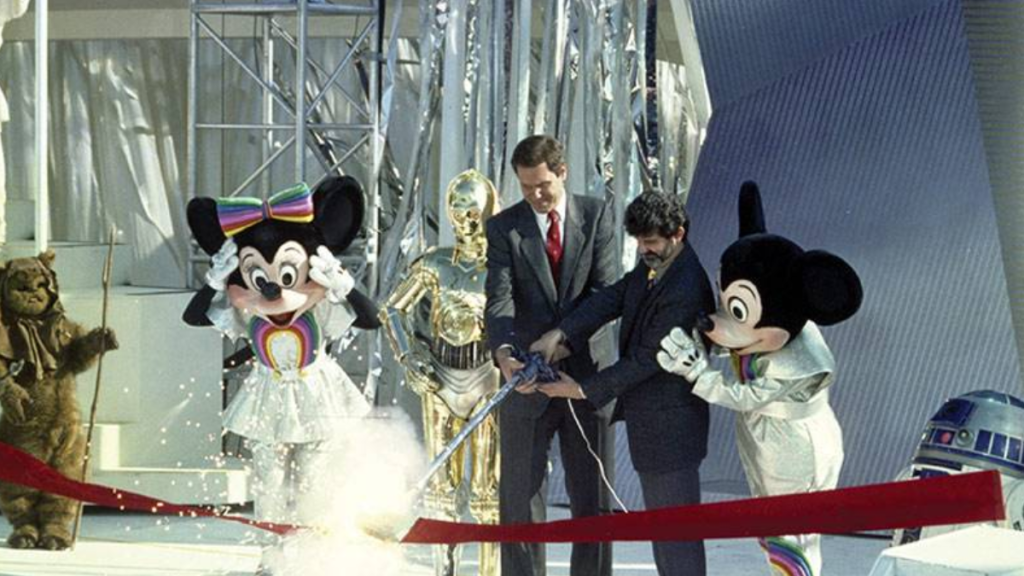
A Dinner Conversation That Changed Advertising Forever
After the Star Tours opening ceremony, a private dinner was held with Disney CEO Michael Eisner, George Lucas, and Eisner’s wife, Jane. During the meal, Eisner asked Rutan and Yeager, “You just made history. You traveled non-stop around the planet on a plane without ever refueling. How are you ever going to top that, career-wise? What are you two gonna do next?”
Without hesitation, Jeana Yeager replied, “Well, after being cramped inside that tiny plane for nine days, I’m just glad to be anywhere else. And even though you folks were nice enough to fly us here, invite us to your party… Well, as soon as we finish eating, I’m gonna go over to the Park and ride some rides. I’m going to Disneyland.”
Jane Eisner immediately recognized the power of Yeager’s statement. On the car ride home, she turned to Michael and said, “That’s a great slogan. I think you should use that to promote the theme parks.” Like many husbands, Michael initially dismissed the idea, but Jane persisted. Eventually, Eisner relented and pitched it to his team.
The Super Bowl Connection
With Super Bowl XXI just around the corner, Disney’s PR team saw an opportunity. The game was set for January 25, 1987, at the Rose Bowl in Pasadena—just miles from Disney Studios. What if they convinced the winning quarterback to say, “I’m going to Disneyland” live on-air?
Disney quickly struck a deal with both quarterbacks—Phil Simms of the New York Giants and John Elway of the Denver Broncos—offering each $75,000 to deliver the line if their team won. Simms led the Giants to victory, making history as the first athlete to say, “I’m going to Disney World!” on national television.
A Marketing Triumph
That year’s Super Bowl had the second-highest viewership in television history, with 87 million people watching Simms say the famous line. The next day, Disney turned the clip into a national commercial, cementing the phrase as a marketing goldmine.
Since then, “I’m going to Disneyland” (or Disney World, depending on the commercial) has been a staple of championship celebrations, spanning the NFL, NBA, and even the Olympics. What started as a casual remark at dinner became one of the most successful advertising campaigns in history.
A Lasting Legacy
Jane Eisner’s keen instinct and Disney’s ability to act quickly on a great idea created a tradition that continues to captivate audiences. The “I’m going to Disneyland” campaign remains a testament to the power of spontaneous inspiration and smart marketing, proving that sometimes, the best ideas come from the most unexpected places.
To learn more about Disney’s ties to the world of sports, check out I Want That Too: A Disney History and Consumer Product Podcast.
Television & Shows
How the Creators of South Park Tricked A-List Celebrities to Roast Universal – “Your Studio & You”
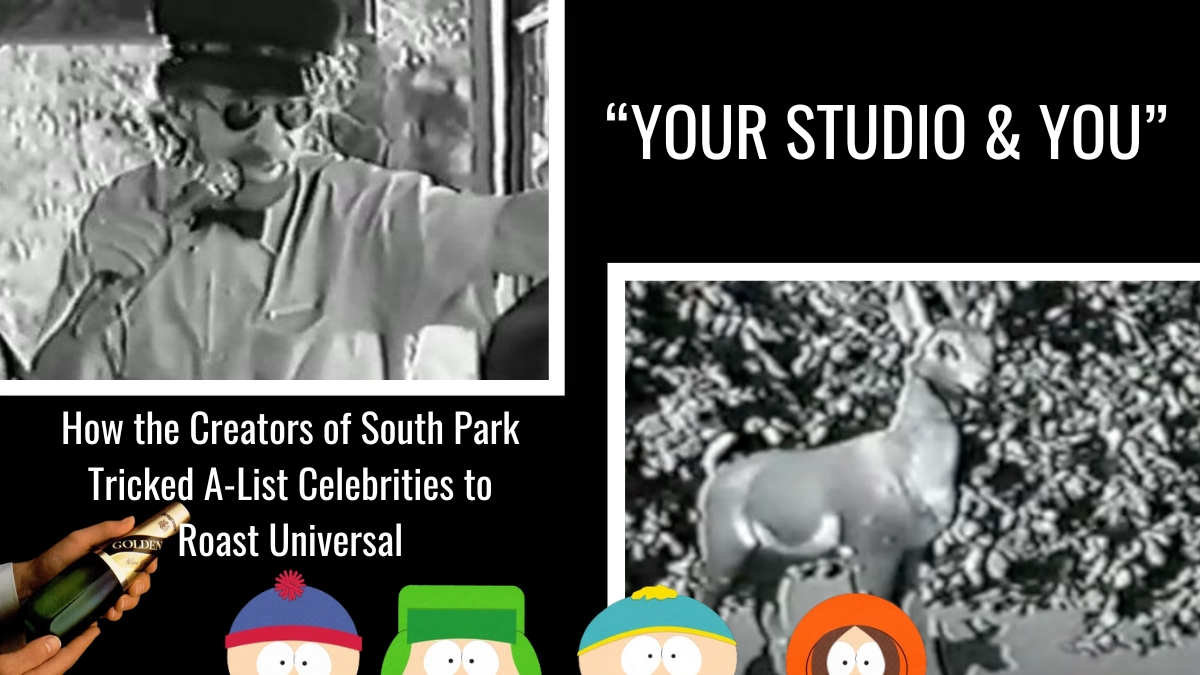
Universal Studios has a rich and storied history, but few moments are as peculiar—and as hilariously cutting—as the creation of Your Studio & You. This 14-minute parody film, commissioned in 1995 to celebrate Universal’s new ownership under Seagram’s, brings together an all-star cast, biting humor, and the unmistakable comedic fingerprints of Matt Stone and Trey Parker.
Long before South Park debuted on Comedy Central in 1997, Stone and Parker were already carving out a reputation for their irreverent style, and Your Studio & You perfectly encapsulates their knack for turning even the most corporate project into something delightfully subversive.
Matt Stone & Trey Parker Before South Park
Stone & Parker were already known out in Hollywood as funny guys. Thanks largely to “The Spirit of Christmas,” which was this video greeting card that they’d crafted for a Fox executive – who then distributed this infamously funny thing (which had Our Lord Jesus Christ & Santa Claus literally duking it out for the holiday affections of Cartman, Kenny, Stan & Kyle) to friends & family.
This was the early 1990s. No internet. Each copy of “The Spirit of Christmas” was made on VHS tape and then mailed. Went viral the old-fashioned way. It’s rumored that George Clooney made over 300 copies of “The Spirit of Christmas” and passed these VHS taps along to friends and family.
Things didn’t move as fast as they do today. “The Spirit of Christmas” still became a sensation out West.
Zucker Brothers
Matt & Trey also had other supporters in the entertainment industry. Among them David Zucker, who was one of the members of ZAZ (i.e., Zucker Abrahams Zucker), the talented trio that made “Airplane!” in 1980, “Top Secret!” in 1984 and the three “Naked Gun” movies.
- The original “Naked Gun” in 1988
- “Naked Gun 2 & 1/2 : The Smell of Fear” in 1991
- and “Naked Gun 33 & a 1/3: The Final Insult” in 1994
All five of these parody films had been made for Paramount Pictures. But in the Late Winter / Early Spring of 1995, Universal had persuaded the Zucker Brothers to come over and set up shop in a bungalow on their lower lot. With the hope that – at some point further on down the line – David & his brother Jerry would start making funny films for Universal.

And it’s during this same window of time (We’re now talking April of 1995) that news breaks that Seagrams (Yep, the adult beverage company. Who – at the time – was making an absolute fortune on the sales of wine coolers) was about to buy a majority stake in MCAUniversal. We’re talking control of 80% of that company’s stock. Which would effectively make Seagrams the new owners of Universal Studios.
Edgar Bronfman
And Edgar Bronfman – the owner of Seagrams – knew that Universal had had a tough time with its previous owners – which had been the Matsushita Electric Industrial Co. of Japan. Matsushita had bought MCA back in November of 1990 for $7.5 billion but had never really understood the entertainment industry.
This is why – after repeatedly butting heads with Lew Wasserman & Sidney Sheinberg (i.e., the heads of Universal Studios & the Universal theme park respectively) when it came to creative control of this company – Matsushita decided to wash it hands of the entire enterprise. Agreeing to sell their holdings in MCA to Seagrams for $5.7 billion (effectively taking a nearly $2 billion loss on this investment).
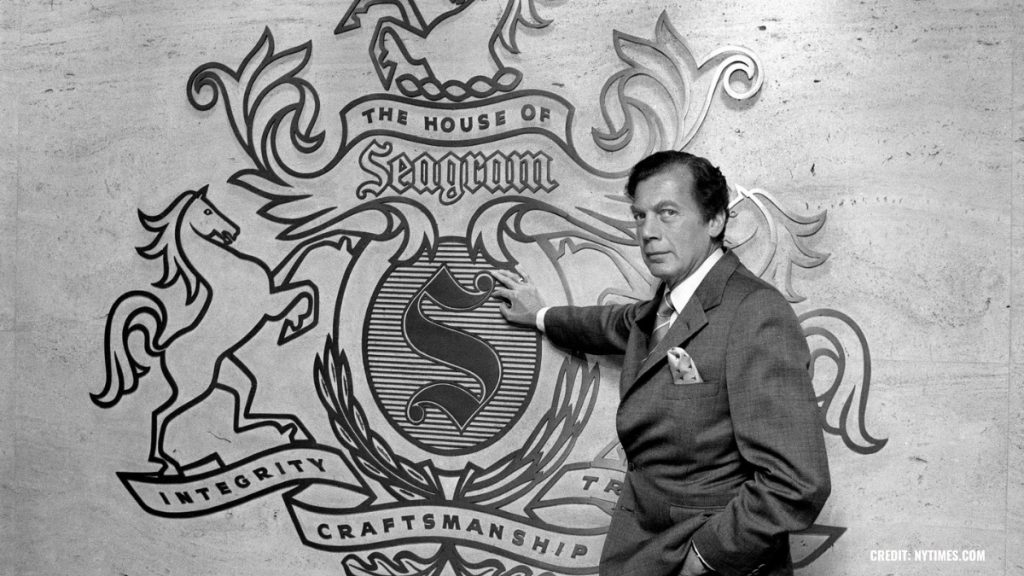
And Bronfman … He knew that some bad feeling had developed between Hollywood’s creative community and the Japanese owners of Universal. The thinking was that executives at Matsushita Electric had just not gotten what it took to make movies & TV shows.
And Edgar? Right from the get-go, he wanted to show that Seagrams was NOT going to be Matsushita Electric Redux. Bronfman was looking for a way to send a clear message to Hollywood’s creative community that Universal’s new owners got it. That they were willing to work with Hollywood to make the best possible movies & TV shows at Universal.
And how did Edgar decide to get this message across? By making a funny movie.
Zucker Commissions Trey Parker for “Your Studio & You”
Mind you, Bronfman himself didn’t make this film. The owner of Seagrams reached out to David Zucker. Who – after initially agreeing to produce this introduction-to-Universal film – then farmed out the production of the actual project to Trey Parker. Who – just two days before shooting was supposed to star on the Universal Lot – persuaded Matt Stone to come help him on this project.
Which brings us to “Your Studio and You.” Which is a parody of an educational film from the 1950s, right down to being shot in black & white and featuring a very generic soundtrack.
Now what’s amazing about watching “Your Studio and You” today is that this 14-minute-long film features some of the biggest names working in Hollywood back in the mid-1990s. We’re talking about people like recent Golden Globe winner Demi Moore, Sylvester Stallone, Michael J. Fox and Angela Lansbury. Not to mention two of the most powerful men in all of Hollywood, Steven Spielberg & Jeffrey Katzenberg.
And what’s especially interesting about watch “Your Studio and You” is that – as you watch these performers go through their paces in this motion pictures (which – most of the time – involves doing some innocuous task while holding a Seagram’s wine cooler) – you often get the feeling that this star is not in on the gag.
So how did Matt & Trey get away with this? Simple. There was never actually a script for “Your Studio and You.”
Filming “Your Studio & You” at Universal Studios Hollywood
Mind you, David Zucker would always insist that there was. Especially when he’d phone up celebrities on the Universal Lot and say “Hey, I’m sending over a couple of college kids later today. They’re working with me on a new parody film. It’s something that we’re doing for the new owners of Universal. I need just a half hour of your time. We’re shooting something special for the party we’ll be holding when the Seagrams people first arrive at the Studio. Absolutely. You’ll definitely get an invite to that party. So can I count on you to help these kids out? Beautiful. They’ll be over there later this morning.”
And then Matt & Trey would show up and say “… Dang, Miss Lansbury. We’re sorry. We must have left our copy of the ‘Your Studio and You’ script back in our office. Which is clear on the other side of the Lot. So – rather than waste your time – why don’t we do this instead? Follow us over to the Psycho House. Where we’re then going to get footage of you painting the front porch on Mother Bates’ house while you say ‘Gosh, with all of the wonderful improvements going on around here, everyone is going to want to work at Universal.’ Oh, and can we also get you to wear this button on the front of your blazer which reads ‘Universal is A-OK’ ? “

And over & over again, the biggest names who were working for Universal at that time took part in the production of “Your Studio & You” because A) David Zucker vouched for Matt Stone & Trey Parker and B) this was something that was being made for the new owners of Universal. And it’s just natural to want to get in good with the new boss.
Steven Spielberg, Jeffery Katzenberg, and Jaws
But no one at Universal anticipated that “Your Studio & You” would wind up being as sharp edged as the finished product turned out to be. I mean, it’s one thing to bite the hand that feeds you. But “Your Studio & You” ? It doesn’t just bite the hand. It takes the hand off at the wrist.
It’s a brutally funny film. With one of the meanest moments reserved for Steven Spielberg, who plays a driver on the Universal Studio Tour who’s trying to persuade a tram full of bored tourists (one of whom is played by Jeffery Katzenberg) that the “Shark Attack” scene down by Jaws Lagoon is actually exciting.
Spielberg actually says lines like “ … Whoa, whoa. What is going on here? Ladies and gentlemen, this never happens. Look out! It’s a shark! Whoa, that is one big scary shark.”
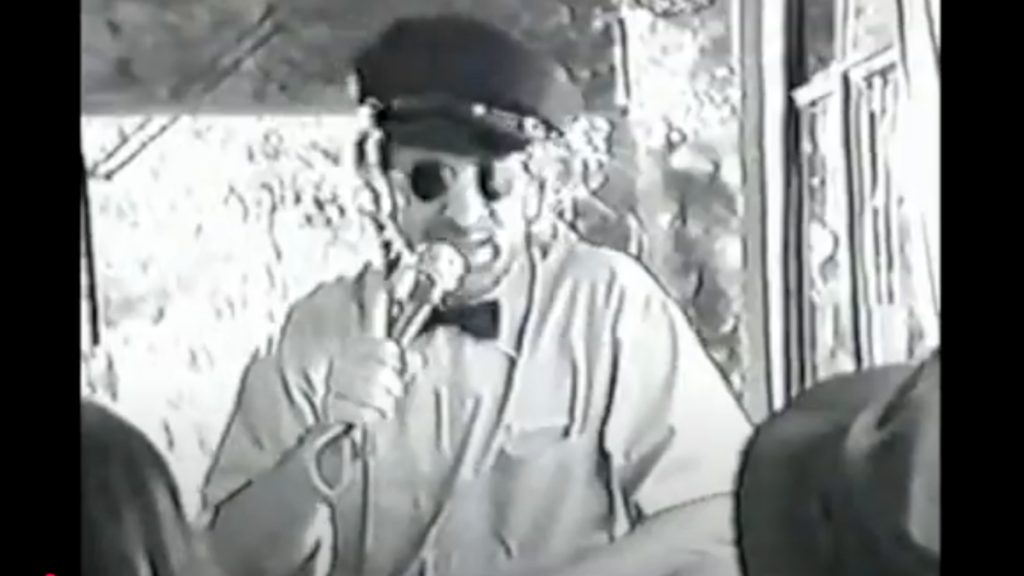
Mind you, as footage of this mechanical shark repeatedly coming up out of the water is shown, “Your Studio & You” ‘s off-screen narrator (who is voiced by Trey Parker says):
“But what about tomorrow? If we don’t keep in step with the times, things that were once neat and thrilling can become old and stupid.”
“Your Studio & You” Reception
This film was supposed to be shown only once at the welcoming party for Seagrams executive on the Universal Lot. And I’m told that – when Edgar Bronfman saw the finished product at that party – he reportedly turned to David Zucker and said “ … That’s a little more mean-spirited that I think it needed to be.”
And with that, “Your Studio & You” was supposed to go back into the Universal vault, never to be seen again. But when “South Park” debuted on Comedy Central in August of 1997 and then became a sensation for its biting humor, there was suddenly a lot of interest in what else Matt & Trey had done. Which is why copies of “The Spirit of Christmas” began to circulate. And – over time – copies of “Your Studio & You” began to bubble up.
Which – as Stone & Parker have repeatedly pointed out – was just not supposed to happen. Largely because none of the celebrities who appeared in “Your Studio & You” had never signed releases for Universal’s legal department. Because – again – this was for a movie that was only going to be shown once at a private function on the Universal Lot.
Matt mentioned (as part of a career retrospective at the Paley Center in LA back in 2000) that “ … they wouldn’t even let us keep a copy of the finished film.”
It’s a funny but brutal movie. And worth taking a look at today especially if you’re a theme park history buff because it shows Universal Studios Hollywood’s “Jurassic Park: The Ride” still under construction on the Lower Lot. That attraction would finally open to the public in June of 1996.
“Your Studio & You” became a lot easier to see after Seagrams sold off its share of Universal to Vivendi in 2000. Copies began propagating online after that. Though Universal Legal will periodically make an effort to get the latest copy of “Your Studio & You” taken off the Internet because – again – none of the performers who appear on camera ever signed the proper releases and/or were paid for their efforts.
That said, if you’re up for a mean-spirited laugh, “Your Studio & You” is well worth 14 minutes of your time. That said, once you watch this thing, be warned:
- You’re immediately going to be thirsty for a Seagram’s wine cooler
- And you’re going to have a sudden desire to go out & buy a porcelain deer.
-

 Theme Parks & Themed Entertainment7 months ago
Theme Parks & Themed Entertainment7 months agoDisney’s Forgotten Halloween Event: The Original Little Monsters on Main Street
-

 Theme Parks & Themed Entertainment8 months ago
Theme Parks & Themed Entertainment8 months agoThe Story of Mickey’s Not-So-Scary Halloween Party: From One Night to a Halloween Family Tradition
-

 Film & Movies8 months ago
Film & Movies8 months agoHow “An American Tail” Led to Disney’s “Hocus Pocus”
-

 Theme Parks & Themed Entertainment6 months ago
Theme Parks & Themed Entertainment6 months agoDisney and Macy’s 90-Year Thanksgiving Day Parade Partnership: From Mickey’s First Balloon to Minnie’s Big Debut
-

 Television & Shows4 months ago
Television & Shows4 months agoHow the Creators of South Park Tricked A-List Celebrities to Roast Universal – “Your Studio & You”
-

 History3 months ago
History3 months agoThe Super Bowl & Disney: The Untold Story Behind ‘I’m Going to Disneyland!’
-

 Podcast4 weeks ago
Podcast4 weeks agoEpic Universal Podcast – Aztec Dancers, Mariachis, Tequila, and Ceremonial Sacrifices?! (Ep. 45)
-

 Television & Shows1 week ago
Television & Shows1 week agoThe Untold Story of Super Soap Weekend at Disney-MGM Studios: How Daytime TV Took Over the Parks






